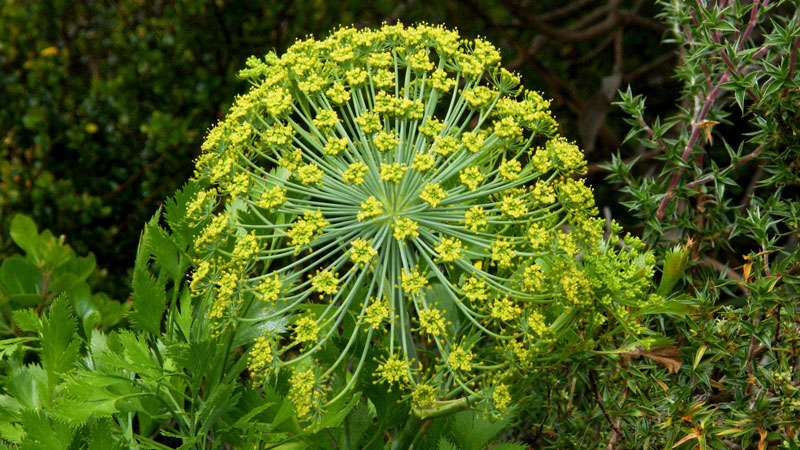Essential oil of the month - Galbanum
Image by: Andrew Massyn / Wikimedia Commons / Creative Commons Attribution-Share Alike 3.0 Unported
Galbanum essential oil is one of those aromatherapy oils that we just don’t think or hear about very often; and, yet, it has been around for a very long time because of its various useful properties! It was originally used by the ancient Egyptians and Romans as holy incense, for embalming and for cosmetic purposes. Galbanum is referenced in the Old Testament, in the writings of Hippocrates (the father of modern medicine) and in Pliny’s Natural History. Ancient Greek physician, Dioscorides, also prescribed the juice of galbanum for a whole host of medical conditions including coughs, convulsions, headaches, menstrual cramps and labour pains, tummy ache, toothache and even snake bites. It was also rubbed on the eyes to improve sight and taken with honey to ease flatulence and indigestion.
Galbanum (Ferula galbaniflua) is a large, perennial herb, belonging to the Apiaceae family, with shiny leaves and umbels of small yellow flowers. It is native to the Middle East and Asia, but distillation of the oil takes place in Europe; particularly France.
The essential oil is steam-distilled from the gum resin that exudes from the plant’s stem. It is a thick, dark yellow coloured, top note oil, with a warm, fresh, green, earthy, woody aroma. It is used as a fixative in the perfume industry and its spicy, green aroma is featured in fragrances such as Chanel No. 19, Must by Cartier, Vent Vert by Balmain, Versace Blue Jeans for Men and Vol de Nuit by Guerlain.
Although Galbanum isn’t commonly used in aromatherapy it does have some useful properties, especially for chronic conditions such as rheumatism. It is also good for skin infections and inflammations that are slow to heal, as well as problems associated with the respiratory, digestive and nervous systems.
Galbanum is also a great essential oil for Summer as it is detoxing and can be used as an insecticide to fight mosquitos! So, if you haven’t heard about this ancient oil, read on for more information about how it can be used.
Skin detoxification and rejuvenation
Firstly, as it has traditionally been used in cosmetics, it is great for detoxification, rejuvenation and healing of the skin, which makes it perfectly suited to acne, abscesses, boils, cuts, infections, inflammation, scars and slow-healing ulcers. It is also great for toning mature and wrinkled skin.
Blend suggestion:
Cleanse your skin with Micellar Water, and then try an exfoliating skin scrub by mixing 3 tbsps of Coconut Sugar (from grocery store), 3-4 tbsps of melted Coconut Butter, 1 drop Galbanum and 1 drop Geranium. Mix well and apply to the skin as a body or face scrub. When you’re done, wash off and add 1 drop of Galbanum essential oil to 5ml of a Moisturising Lotion and massage into your skin to finish the routine.
Stress, shock, trauma & depression
Galbanum oil is really calming, grounding and balancing for the mind and spirit! If you think about the environments it grows in – often those such as Iran and Afghanistan – it is a hardy plant that is surrounded by war-torn culture; I couldn’t think of a better place for a plant that helps trauma to grow, and you often find that nature grows things where it is needed to support life. So, for real trauma states, depression, shock and stress, think of Galbanum essential oil. It is an uplifting and yet grounding heart chakra oil, which will help you to let go of emotion!
It is also used as a meditation aid to calm, reveal truth and encourage soul-searching.
Blend suggestion:
To release feelings of high emotion, shock, nervousness and trauma, use a calming diffuser blend. Add 3 drops Galbanum, 2 drops Lavender and 2 drops Rose to an aromatherapy diffuser or candle burner and diffuse as needed throughout the day.
Circulation, joints & muscles
Galbanum is great for increasing circulation and is also thought to have pain-killing and antispasmodic properties, making it useful in massage blends for sore joints, muscle pain and spasm, and conditions such as arthritis, and rheumatism
Blend suggestion:
Mix up a massage oil with 15ml Grapeseed oil, 3 drops Galbanum, 2 drops Lavender and 1 drop Frankincense and apply to your problematic joints and muscles, massaging in a direction towards your heart.
Digestive problems
This oil’s carminative and tonic properties make it a great oil for digestive difficulty. If you’re feeling flatulent, or if you’re having tummy cramps, or a lot of water retention, it’s a good oil to try.
Blend suggestion:
Mix up a tummy massage blend 15ml Grapeseed oil, 3 drops Galbanum and 3 drops Chamomile and apply to the abdomen, massaging in a clockwise direction.
Respiratory support
Galbanum is also great for supporting the respiratory system in times of struggle. It’s an expectorant and an anti-microbial tonic, so great for ridding bugs!
Blend suggestion:
Add 3 drops of Galbanum oil onto a cotton pad rolled up inside an Aromatherapy Inhalator and inhale as required to support respiratory problems.
Natural insecticide
For those summer holiday mozzies, try making a natural mosquito repellent using Galbanum!
Blend suggestion:
In a spritz bottle, add 10 drops Galbanum, 10 drops Citronella and 10 drops Lavender essential oil to 100ml of Orange Flower (Neroli) Hydrolat. Shake well and spray onto skin and hair as a natural insecticide.
Alternative oils you may also love:
Frankincense, Carrot Seed, Myrrh.
Galbanum combines well with:
Chamomile, Citronella, Fir, Frankincense, Geranium, Grapefruit, Jasmine, Lemon, Lavender, Pine, Rose, Sweet Orange and Ylang Ylang.
As you can see, although not commonly used in aromatherapy, Galbanum is an extremely versatile oil that can be particularly useful for persistent pain and for healing and rejuvenating the skin.
Why not try something different and give Galbanum a go!
Safety note:
Galbanum is an emmenagogue, which encourages menstruation, so should be avoided during pregnancy.
Nicole Barton
Consultant Aromatherapist
Read other articles by Nicole Barton





